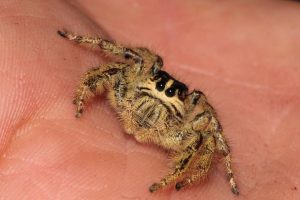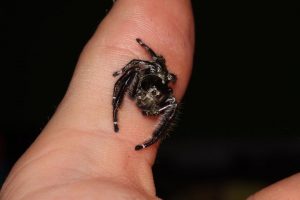Copyright 2021 Evolution Reptiles
All rights reserved.
Copyright 2025 Evolution Reptiles
All rights reserved.
All rights reserved.
These charming little spiders have become very popular as pets recently, and with good reason – they are ridiculously cute! With large, forward facing eyes and fuzzy bodies, fairly short legs and an endearing habit of cocking their head to regard their keeper, they are a long way from the traditional, scary spider type.
Unlike a lot of spiders, these are easy to sex once they become juveniles. Males are black with a pattern of white spots and stripes on their abdomen, and have greenish blue chelicerae although this isn’t as obvious as it is on some other species of jumping spider. Females have a similar pattern of spots and stripes, but are either shades of grey or brown with reddish areas on some individuals. Adult eyelash jumpers range from 6 to 22mm, with females usually on the larger side. As they are one of the largest jumping spiders they also have the common names of heavy jumping spider and giant jumping spider. The ‘eyelash’ part of the name is obvious in sub adult to adult individuals, as they have a tuft of hair just behind their eyes which does look remarkably like a pair of long and beautiful eyelashes!

Any enclosure for eyelash jumpers should be taller than it is long, and should have plenty of places for your spider to perch. Keep the humidity fairly high by spraying regularly, and by using a substrate that will hold some water as well as plenty of leaf litter. They do like bright light, and if it is too shady then they are less likely to feed and thrive. Considering that they are both diurnal and appreciate brightness, it would be very interesting to see if providing UV light would improve the care of this species. If you do use supplemental lighting, be aware of the temperatures in the enclosure. If you do need supplemental heating, then small heat mats mounted on the side of the enclosure will usually give the boost in temperature required.
Your enclosure for your jumping spider can be as simple as a large deli cup, or it can be a larger front opening glass tank with custom lighting – as long as the spider has a range of perches and somewhere to web up a hammock to sleep in and hunt from. If using a deli cup, be careful not to damage this web when lifting the lid to add food or spray water.
You will find that your jumping spider will make a slightly thicker hammock to hide in when they are shedding their skin. Do not disturb them at this point! Lightly mist the enclosure, and be very careful not to tear or otherwise damage the web. After it has shed, your spider will probably rest for a day or two while its new skin hardens up, and then it will be out and about again looking for food. When they are hunting they will attach themselves to the wall or a piece of decor with a dragline of silk, so that if they miss their mark they don’t fall to the ground, potentially hurting themselves.

Jumping spiders can become surprisingly tame, some being happy to accept being hand fed and others even capable of being trained to jump from hand to hand! They are not fussy about their food, either. Any live invertebrate of a suitable size will be taken, although watching them jump to hunt flies can be quite spectacular. Food items should be no larger than the abdomen of your spider, and a good variety of different foods will be appreciated. There is no need to dust with supplements, but it is always a good idea to gut load your feeder insects in order to maximise their nutritional value.
Like most spiders, jumping spiders should be kept singly. Keeping more than one in an enclosure rarely ends well. The only real downside to keeping this species is that they do not live long; 10 months seems to be the usual lifespan, but some will make it to 12months.
Copyright 2021 Evolution Reptiles
All rights reserved.